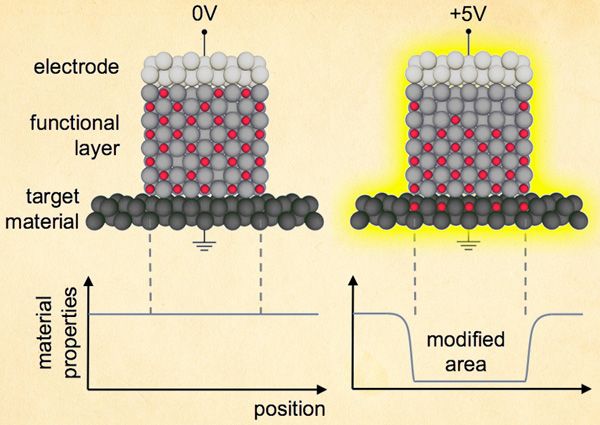A new way of switching the magnetic properties of a material using just a small applied voltage could signal the beginning of a new family of materials with a variety of switchable properties, according to a team of MIT-based researchers. The technique could let a small electrical signal change materials’ electrical, thermal, and optical characteristics.

The findings were published online Nov. 17 in the journal Nature Materials by MIT doctoral student Uwe Bauer; MIT Associate Professor of Materials Science and Engineering Geoffrey Beach; Lide Yao and Sebastiaan van Dijken of Aalto University in Finland; MIT graduate students Aik Jun Tan, Parnika Agrawal, and Satoru Emori; and MIT Professor of Ceramics and Electronic Materials Harry Tuller. The work was supported by the National Science Foundation and Samsung.
Beach says the work could lead to a new kind of nonvolatile, ultralow-power memory chip that requires no power to maintain data once it’s written, drastically lowering its overall power needs.
The structure of these devices is similar to that of a capacitor, Beach explains, with two thin layers of conductive material separated by an insulating layer. Unlike in a capacitor, however, the conductive layers in the low-power chips are magnetized. One conductive layer has fixed magnetization, but the other can be toggled between two magnetic orientations by applying a voltage to it. When the magnetic orientations are aligned, it is easier for electrons to tunnel from one layer to the other; when they have opposite orientations, the device is more insulating.
Just a small voltage is required to flip the state of the device, which then retains its new state even after power is switched off. Conventional memory devices require a continuous source of power to maintain their state.
This diagram shows the principle behind using voltage to change material properties. In this sandwich of materials, applying a voltage results in movement of ions — electrically charged atoms — from the middle, functional layer of material into the target layer. This modifies some of the properties of the target material, and the changes remain after the voltage is removed. Diagram courtesy of the researchers; edited by Jose-Luis Olivares/MIT.
For more detail: Researchers use voltage to control magnetic memory
